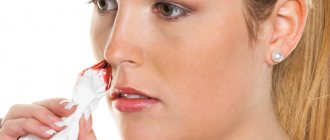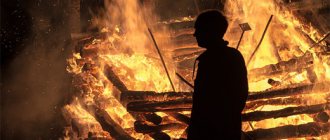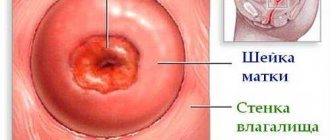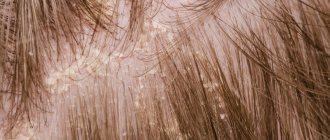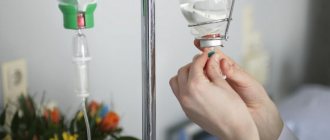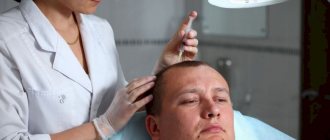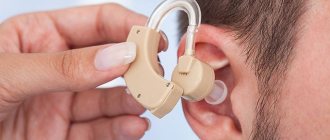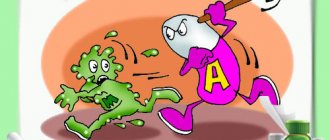A wound that results in projectile fragments, bullets, and shot entering the human body is called a gunshot wound. Such injuries are classified as fatal, so the person must be immediately taken to a medical facility.
First aid for a gunshot wound is provided according to the general algorithm, regardless of the striking object that caused it. However, there are minor differences in emergency actions depending on the location of the injury.
Abdominal wound with eventeration of internal organs
And finally, a few words about internal bleeding.
They manifest themselves as hemoptysis, bloody vomiting, blood in the stool, and bloody vaginal discharge. It should be remembered that the blood, under the influence of hydrochloric acid in the stomach, turns black, and signs of bleeding can also include black vomit (the so-called “coffee grounds”) and loose black stools.
Generally speaking, it is impossible to stop internal bleeding at the prehospital stage. In such cases, you should immediately call an ambulance. And before the doctors arrive, it is necessary to provide the patient with peace, if possible, to put him to bed.
In case of hemoptysis or bloody vomiting, the patient should be given very cold water to drink in small sips and small pieces of ice to be swallowed. You can put ice on the sternum for hemoptysis, in the left hypochondrium for hematemesis, on the anus for heavy hemorrhoidal bleeding, and on the lower abdomen for vaginal discharge. A belt that is too tight should be loosened.
Many people tend to be scared by the sight of blood. In addition, spilled blood has this peculiarity - it always seems to be more than it is; 200-300 ml of blood on clothes and on the floor visually gives the impression of “bloody puddles”.
Puncture type of wound
Puncture types of wounds are one of the most dangerous phenomena. The injury appears to be minor. However, its depth can be very large, which means there is a risk of damage to internal organs, and as a result, the development of internal bleeding.
A puncture wound can be inflicted with a needle, awl or bayonet. With this type of wound, it is important to immediately provide assistance to the victim and diagnose the area where the damage was caused.
What are the risks of blood loss?
During the Great Patriotic War, a third (and according to some sources, half) of those killed on the battlefield died from blood loss. And in our time, untimely stopping of bleeding is one of the main causes of death in road accidents.
And there is not much time allotted to provide assistance. If large arteries are injured - carotid or femoral - a person can die from blood loss within 10-15 minutes.
Blood loss in a volume of up to 500 ml usually does not cause significant disruptions in vital functions; at this stage, the body’s compensatory capabilities are sufficient.
But the loss of 1 liter of blood already leads to severe circulatory disorders, and blood loss of 2 liters or more poses a real threat to life.
However, these figures are approximate. The severity of the lesion depends on the initial condition of the victim - cold, hunger and fatigue worsen the prognosis. Children and old people endure blood loss more severely than young people, men more severely than women.
The combination of painful shock and blood loss significantly aggravates the victim's condition. The rate of blood loss also matters. When large vessels are damaged, when blood is lost very quickly, death sometimes occurs with the loss of 1 liter of blood or even less, since in such cases compensatory mechanisms do not have time to turn on.
Treatment methods
In case of injury to the soft tissues of the head, treatment is prescribed depending on the injury. If the injuries are mild, then hospitalization is not performed; alcohol and warming compresses are prescribed for the hematoma (but after two days after the injury). For more serious injuries, physiotherapy is prescribed. In certain cases, the patient is hospitalized, treatment is prescribed and detailed monitoring of the condition is carried out.
The following medications are prescribed:
- Troxerutin is a drug that reduces the level of swelling and allows you to improve blood circulation in the area of damage. The drug is in the form of an ointment.
- Stugeron has a targeted effect, dilates blood vessels, provides better patency, which generally reduces the level of pain, and also relieves swelling.
- Fastum-gel is an anti-inflammatory agent for external use, which in addition to everything has a high analgesic effect.
- Dolobene – provides a quick process of removing excess fluid from blood vessels, eliminates swelling and prevents inflammation.
The use of these products allows you to get rid of bruising and swelling, but they must be prescribed by a specialist, taking into account all possible contraindications.
If you follow all the doctor’s recommendations, then within 14 days you can completely eliminate all the consequences of a slight bruise.
If the damage is more serious, minor surgery . Under local anesthesia, small incisions are made through which the accumulated fluid is removed (if the swelling does not go away for a long time). If a focus of inflammation occurs, incisions are also made and drainage is installed, and antibiotics are additionally prescribed.
Stopping arterial bleeding with a twist
Methods for stopping bleeding are, in turn, divided into mechanical, chemical and thermal. In addition, a distinction is made between permanent and temporary stoppage of bleeding.
At the prehospital stage, essentially only a temporary stop of bleeding is possible, which presupposes the provision of qualified medical care in the future.
Chemical methods at the prehospital stage can only stop capillary bleeding. The point of the method is to use substances that enhance blood clotting - for example, silver, lead.
Straight razors are a thing of the past, and lapis shaving pencil is becoming increasingly rare in pharmacies - it contains silver salts, and it does a good job of stopping bleeding from small cuts.
Hydrogen peroxide also has hemostatic properties. It is used to moisten tampons to stop nosebleeds or to tamponade a wound; it is used to stop capillary bleeding.
Collagen hemostatic sponge is also used from pharmaceutical products; it quickly and effectively stops minor bleeding.
Based on my experience, I would also classify such a “remedy” as newsprint as a chemical means of stopping bleeding. It has been tested many times - it stops bleeding much better than any other.
I used to attribute this to the lead in printing ink, but as far as I know, lead has been out of use for a long time, and newsprint still helps.
The thermal method is used mainly during surgery - this is electrothermocoagulation, cauterization of small vessels during the operation. In out-of-hospital conditions, in everyday life, we resort to this method when we apply snow to minor injuries or lower the wounded hand into very cold water.
The main method of stopping bleeding from large vessels - both temporarily and permanently - is mechanical.
a – subclavian b – femoral c – popliteal
g – shoulder and elbow
What not to do
- Under no circumstances should you fill the wound with iodine tincture . This will lead to a chemical burn in the wound, and it will be difficult to heal. This rule also applies to a solution of brilliant green, hydrogen peroxide, if we are talking about deep damage.
- Do not touch the edges of the wound with dirty hands .
- If there are cutting objects (a piece of glass is stuck, for example), then under no circumstances remove them yourself. This leads to repeated tissue injury and increased blood loss.
- Do not remove the bandage soaked in blood, but apply a new layer of dressing material on top.
- There should be no delay in transporting the victim to the hospital.
Application of an improvised hemostatic tourniquet
And finally, about applying a tourniquet. For some reason, this is what people remember best after school anatomy lessons or driving courses. Meanwhile, a tourniquet, as the least physiological of all methods, should be a last resort and should be used only when all other methods are ineffective.
Of course, if blood is gushing from a wound like water from a tap, there is no point in trying to apply a pressure bandage, but in general, in the prehospital stage, a tourniquet is applied unreasonably often - and often incorrectly.
There is no need to describe the technique of applying a tourniquet in detail. The tourniquet is a rubber strip, which is stretched strongly, applied tightly in 2-3 turns on the limbs above the wound and secured.
In out-of-hospital conditions, you can use, for example, a rubber catheter or a tonometer tube as a tourniquet, and in the absence of suitable material, make a twist from a bandage, rope or strip of fabric.
The tourniquet injures the skin and soft tissues, compresses the nerves and disrupts blood circulation in the affected limb, so you must remember the following rules:
- The tourniquet should not be applied to bare skin. If for some reason you cannot put it on your clothes, then you should at least put a bandage or scarf under it.
- The tourniquet must not be covered with clothing; it must be visible. The fact is that at different stages different people can provide assistance to the victim, and they may simply not know or forget about the tourniquet hidden under a sleeve or trouser leg.
- The tourniquet cannot be applied for a long time. Previously, it was believed that the tourniquet could be left on for 2 hours (and in winter, in cold weather, for 1 hour). Now these terms are no longer considered safe. It is strongly recommended not to leave the tourniquet on for longer than 1 hour. In this case, every 20-30 minutes you need to loosen it for 5-10 minutes. If bleeding resumes when the tourniquet is removed, then another method (usually finger pressure) must be used for these few minutes. If after removing the tourniquet there is no bleeding, then there is no need to reapply it. In this case, a pressure bandage should be applied to the wound. Each time you apply a tourniquet, you should place a note under it indicating the exact time so you don’t forget when it was applied.
- The tourniquet should not be tightened too much. If the bleeding has stopped, that’s it; you shouldn’t pull (or tighten) any further. However, a tourniquet that is not tightened tightly enough is dangerous - it can increase bleeding due to the fact that the blood flow through the artery will continue, but the venous outflow will be interrupted, and the pressure in the vessels will become higher.
- The tourniquet is not applied to the forearm, hand and lower leg. In these places, the blood vessels are located between the bone formations, and it is impossible to compress them with a tourniquet. If you are wounded in these places and need to use a tourniquet, it is applied to the shoulder or thigh.
I once encountered a situation where, on a hike, tourists applied a tourniquet to a wounded person in violation of almost all of these rules. Including the very first thing - that a tourniquet should be applied as a last resort.
a – stretching the tourniquet, b – fixing the tourniquet using a chain and hook
a – arterial bleeding, b – “tourniquet” from a rubber tube, c – “tourniquet” from a belt
Thrombosis
It must be remembered that no matter what method of stopping bleeding was used, thrombosis processes occur in the body, which should themselves lead to blockage of damaged vessels.
In order not to damage the resulting blood clot or dislodge it, it is recommended to immobilize the wounded limb. The most effective in this sense is splinting.
Ideally, if it is possible to use an inflatable splint, it will also reduce bleeding by compressing the blood vessels. But usually you have to make do with an improvised tire made from scrap materials.
And, of course, the victim should be taken to a doctor. Even if the bleeding has already stopped, observation by a surgeon is still necessary. The fact is that once bleeding has stopped, it can resume - these are so-called secondary bleedings.
Rules for calling an ambulance in case of a gunshot wound
The tire should be covered with cotton wool or cloth.
Fix two joints above and below the fracture site, and in case of a hip fracture, three joints.
Securely attach splints to fix the fracture area.
Exception: in case of a fracture of the radius, one wrist joint is fixed in a typical place, and in case of ankle fractures - the ankle joint
The first stage of providing first aid to a victim of a gunshot wound is to assess the situation and examine him for existing external
. If a person has visible heavy bleeding as blood comes out of the
jet, then, first of all, it needs to be stopped and only after that call an ambulance. If the bleeding does not appear as a stream, then first call an ambulance.
If the ambulance does not arrive at the scene within 30 minutes, then you should independently transport the victim to the nearest hospital. To do this, you can use any means - your own car, passing transport, etc.
Closed head injuries
If damage to the bones of the upper part of the skull has occurred, it is almost impossible to determine whether there is a fracture without an x-ray examination. Therefore, if you hit the scalp, it would be a mistake to think that it was just a bruise. The victim must be placed on a stretcher without a pillow, ice applied to the head and taken to a medical facility. If such an injury is accompanied by nausea, vomiting, disturbances of consciousness and breathing, then assistance should be provided in accordance with the existing symptoms, including chest compressions and artificial respiration.
The most severe and dangerous head injury is a fracture of the base of the skull. This injury often occurs when falling from a height, and is characterized by brain damage. A distinctive sign of a basal skull fracture is the discharge of colorless fluid (CSF) or blood from the ears and nose. If an injury to the facial nerve also occurs, the victim will experience facial asymmetry. The patient has a rare pulse, and a day later hemorrhage develops in the orbital area.
Please note: transporting a victim with a fracture of the base of the skull must be extremely careful, without shaking the stretcher. The patient is placed on a stretcher on his stomach (in this case, it is necessary to constantly monitor the absence of vomiting) or on his back, but in this position his head should be carefully turned to the side if he begins to vomit. To avoid tongue retraction when transporting on the back, the patient’s mouth is opened slightly and a bandage is placed under the tongue (it is pulled slightly forward).
First aid for burn shock
Pain relief with narcotic (promedol, morphine, omnopon) and non-narcotic (fentanyl, droperidol, ketarol) analgesics
Intravenous transfusion of crystalloid solutions (Ringer's solution, physiological solution) in a stream of 800-1000 ml
Intravenous transfusion of anti-shock blood substitutes (refortan, reopoliglucin, reomax, polyglucin) 400-800ml
Relief of pain with narcotic analgesics (morphine, promedol, omnopon)
Wrapping the victim in a sterile or non-sterile (if not available) sheet
Infusion therapy in an ambulance: crystalloid solutions (saline, Ringer's solution), glucose 50%, detoxification blood substitutes (hemodez, polydesis), high molecular weight hemodynamic blood substitutes (reopolyglucin, polyglucin, refortan)
Antihistamines (diphenhydramine, pipolfen, suprastin)
Glucocorticoids (prednisone, dexomethasone, hydrocortisone) 30 mg IM or IV
Chemical burns
1. Stop exposure to high temperatures.
2.Cut and remove clothing.
3.Apply a dry aseptic bandage.
4.Administer painkillers and give plenty of fluids to drink.
1. For acid burns, rinse the burn surface for 15-20 minutes with a stream of cold water or a 3% soda solution.
2. In case of a burn with alkalis, rinse with a stream of water or a 2% solution of acetic or citric acid.
3.In case of a burn with phosphorus, remove pieces of phosphorus with a stick or cotton wool. Treat the burn surface with a 5% solution of copper sulfate.
